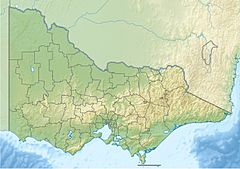Fiery Creek (Victoria) facts for kids
Quick facts for kids Fiery Creek |
|
|---|---|
| Country | Australia |
| State | Victoria |
| Local Government Areas |
|
| Towns |
|
| Physical characteristics | |
| Main source | 760 metres (2,490 ft) 37°17′06″S 143°14′10″E / 37.285°S 143.236°E |
| River mouth | Lake Bolac 212 metres (696 ft) 37°44′02″S 142°52′44″E / 37.734°S 142.879°E |
| Basin features | |
| River system | Hopkins River |
| Tributaries |
|
| Bridges |
|
Fiery Creek is a small river in western Victoria, Australia. It starts high up on Mount Cole in the Mount Cole State Forest. The creek flows south and eventually reaches Lake Bolac. It is part of the larger Hopkins River system.
The Creek's Journey
Fiery Creek begins in hilly areas. These hills have a type of rock called granite. As the granite slowly breaks down, it creates sandy soil. For most of its path, the creek flows through flat farmland. Near its end, the creek meets an old lava flow. This lava flow changes the creek's direction, making it turn west towards Lake Bolac.
Water for Towns
Water from the upper part of Fiery Creek is used to supply drinking water. The Central Highlands Region Water Corporation takes water from the creek. This water helps supply the town of Beaufort.
People have been tracking the creek's water flow at Streatham for over 100 years. Sometimes, the creek has no water flowing at all. But it can also have huge floods. For example, in January 2011, a record amount of water flowed through it.
Gold Rush History
Fiery Creek played a big part in the Victorian gold rush during the 1850s. Gold was found in the upper parts of the creek, close to Raglan.
The gold rush near Beaufort began in 1852. Gold was first found in smaller streams that flow into Fiery Creek. By 1854, gold was also found directly in Fiery Creek, north of Beaufort.
At its busiest time in the late 1850s, about 100,000 people were looking for gold in this area. Between 1855 and 1856, they found a massive 450,000 ounces of gold! The main gold rush at Fiery Creek started in 1854 and mostly ended by 1859. Some gold digging continued until about 1918.


